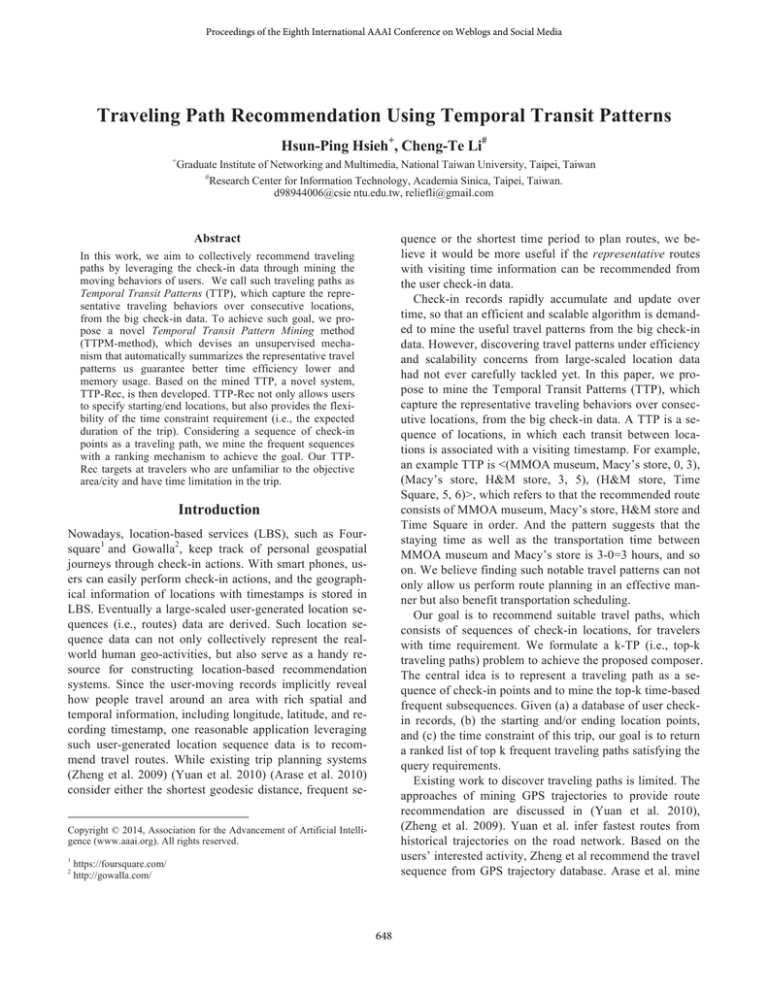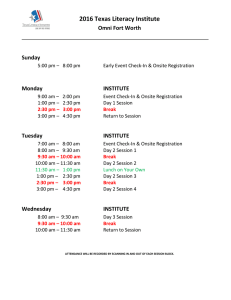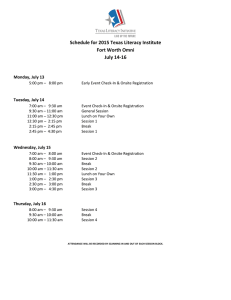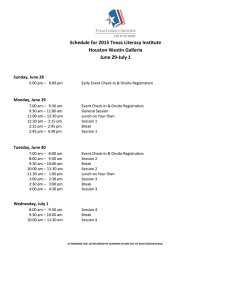
Proceedings of the Eighth International AAAI Conference on Weblogs and Social Media
Traveling Path Recommendation Using Temporal Transit Patterns
Hsun-Ping Hsieh+, Cheng-Te Li#
+
Graduate Institute of Networking and Multimedia, National Taiwan University, Taipei, Taiwan
#
Research Center for Information Technology, Academia Sinica, Taipei, Taiwan.
d98944006@csie ntu.edu.tw, reliefli@gmail.com
Abstract
quence or the shortest time period to plan routes, we believe it would be more useful if the representative routes
with visiting time information can be recommended from
the user check-in data.
Check-in records rapidly accumulate and update over
time, so that an efficient and scalable algorithm is demanded to mine the useful travel patterns from the big check-in
data. However, discovering travel patterns under efficiency
and scalability concerns from large-scaled location data
had not ever carefully tackled yet. In this paper, we propose to mine the Temporal Transit Patterns (TTP), which
capture the representative traveling behaviors over consecutive locations, from the big check-in data. A TTP is a sequence of locations, in which each transit between locations is associated with a visiting timestamp. For example,
an example TTP is <(MMOA museum, Macy’s store, 0, 3),
(Macy’s store, H&M store, 3, 5), (H&M store, Time
Square, 5, 6)>, which refers to that the recommended route
consists of MMOA museum, Macy’s store, H&M store and
Time Square in order. And the pattern suggests that the
staying time as well as the transportation time between
MMOA museum and Macy’s store is 3-0=3 hours, and so
on. We believe finding such notable travel patterns can not
only allow us perform route planning in an effective manner but also benefit transportation scheduling.
Our goal is to recommend suitable travel paths, which
consists of sequences of check-in locations, for travelers
with time requirement. We formulate a k-TP (i.e., top-k
traveling paths) problem to achieve the proposed composer.
The central idea is to represent a traveling path as a sequence of check-in points and to mine the top-k time-based
frequent subsequences. Given (a) a database of user checkin records, (b) the starting and/or ending location points,
and (c) the time constraint of this trip, our goal is to return
a ranked list of top k frequent traveling paths satisfying the
query requirements.
Existing work to discover traveling paths is limited. The
approaches of mining GPS trajectories to provide route
recommendation are discussed in (Yuan et al. 2010),
(Zheng et al. 2009). Yuan et al. infer fastest routes from
historical trajectories on the road network. Based on the
users’ interested activity, Zheng et al recommend the travel
sequence from GPS trajectory database. Arase et al. mine
In this work, we aim to collectively recommend traveling
paths by leveraging the check-in data through mining the
moving behaviors of users. We call such traveling paths as
Temporal Transit Patterns (TTP), which capture the representative traveling behaviors over consecutive locations,
from the big check-in data. To achieve such goal, we propose a novel Temporal Transit Pattern Mining method
(TTPM-method), which devises an unsupervised mechanism that automatically summarizes the representative travel
patterns us guarantee better time efficiency lower and
memory usage. Based on the mined TTP, a novel system,
TTP-Rec, is then developed. TTP-Rec not only allows users
to specify starting/end locations, but also provides the flexibility of the time constraint requirement (i.e., the expected
duration of the trip). Considering a sequence of check-in
points as a traveling path, we mine the frequent sequences
with a ranking mechanism to achieve the goal. Our TTPRec targets at travelers who are unfamiliar to the objective
area/city and have time limitation in the trip.
Introduction
Nowadays, location-based services (LBS), such as Foursquare1 and Gowalla2, keep track of personal geospatial
journeys through check-in actions. With smart phones, users can easily perform check-in actions, and the geographical information of locations with timestamps is stored in
LBS. Eventually a large-scaled user-generated location sequences (i.e., routes) data are derived. Such location sequence data can not only collectively represent the realworld human geo-activities, but also serve as a handy resource for constructing location-based recommendation
systems. Since the user-moving records implicitly reveal
how people travel around an area with rich spatial and
temporal information, including longitude, latitude, and recording timestamp, one reasonable application leveraging
such user-generated location sequence data is to recommend travel routes. While existing trip planning systems
(Zheng et al. 2009) (Yuan et al. 2010) (Arase et al. 2010)
consider either the shortest geodesic distance, frequent seCopyright © 2014, Association for the Advancement of Artificial Intelligence (www.aaai.org). All rights reserved.
1
2
https://foursquare.com/
http://gowalla.com/
648
we build the projected database for each frequent k-pattern
found. And then we scan its projected database to find local
frequent 1-patterns e which is connected with P. For each
local frequent 1-pattern e, we concatenate P with e to form
a frequent (k+1)-pattern. The concatenations are recursively
performed in a depth-first search manner until no more frequent closed patterns can be found.
To return a ranked list of top-k traveling paths, we provide three ranking criteria. The first one is the support value, which determines the popularity of mined subsequences. The second one is the time constraint. If the total time
of a mined traveling path is much shorter than time constraint, the remaining time could be wasted. We rank traveling paths based on the remaining time (the less, the better). The third one is the social effect. If a user has some
check-in records in the past, we model user similarity according to the location type they visited in the history, and
give higher rank for the routes generated from similar users.
Such three ranking criteria can be combined to have better
quality of traveling paths.
travelers’ frequent trip patterns from photo database (Arase
et al. 2010). To the best of our knowledge, we are the first
to tackle the recommendation of frequent traveling paths
with time constraints using location-based check-in data.
The Proposed Method
We collect a large-scaled check-in data from Gowalla,
which contains 6,442,890 check-ins and 950,327 friendships from Feb. 2009 to Oct. 2010. We give the system
overview of TTP-Rec in Figure 1.
Preprocessing. For each user, we transform his checkin records into sequences of locations. We also associate
the time span between two consecutive locations by averaging the time duration between two check-in places for all
people. A database of traveling paths is then built.
System Interface
The system interface of TTP-Rec is shown in Figure 2.
Travelers are allowed to input initial and destination locations or choose popular attractions we suggest, as well as
the expected travel time duration. The generation top-k
traveling paths are shown in the right panel. Furthermore,
TTP-Rec can also recommend the transportation mode between locations, which is developed by integrating with
Google Map API.
Figure 1. System Overview.
Temporal Transit Patterns Mining. We model the
travel behaviors among locations into a Route Transit
Graph (RTG), in which nodes represents locations, and
edges denotes the transit behaviors of users between locations with certain time intervals. The time-aware transit
patterns, which are required to satisfy frequent, closed, and
connected requirements due to respectively physical meanings, are mined based on the RTG transaction database.
The goal is to mine frequent subsequence from the database of traveling paths. For a query containing some locations with a time constraint, our TTP-Rec system first retrieves the sequences with query locations. Then we devise
a TTPM-method to find the frequent paths of locations. A
Temporal Transit Pattern is defined as <(S1, D1, ts1, te1), (S2,
D2, ts2, te2), ..., (Sh, Dh, tsh, teh)>, where ts1=0, and all the
edges in the pattern are sorted in increasing order. The temporal transit pattern should satisfy route connected property,
which means a TTP <(s1, d1, ts1, te1), (s2, d2, ts2, te2), ..., (sh,
dh, tsh, teh)> should follows route connected constraint if ∀ si
∈ {s2, s3,..., sh} we can always find an edge (i, j) whose i< j,
and dj = si or sj = s1. We measure the importance of a subsequence by calculating its support value, which is the number of sequence containing such subsequence. A subsequence P is frequent if its support is not less than minsup,
where minsup is a user-specified minimum support threshold. In our system, we prefer to set minsup = 10% to ensure
that the system contains enough traveling paths. The proposed algorithm consists of two stages. First, we mine all
frequent patterns of length one (denotes 1-patterns), P in the
database. Next, for each frequent k-pattern (k ≥ 1) found P,
Figure 2. The interface of TTP-Rec system.
References
Arase,Y., Xie, X., Hara, T., and Nishio, S.. Mining people’s trips
from large scale geo-tagged photos. In ACM MM, pages 133142, 2010.
Yuan, J., Zheng, Y., Zhang, C., Xie, W., Xie, X., Sun, G., and
Huang, Y.. T-drive: driving directions based on taxi trajectories.
In ACM GIS, pages 99-108, 2010.
Zheng, Y., Zhang, L., Xie X, and Ma, W.-Y. Mining interesting
locations and travel sequences from GPS trajectories. In WWW,
pages 791-800, 2009.
649






